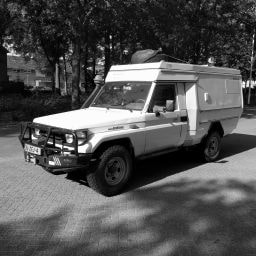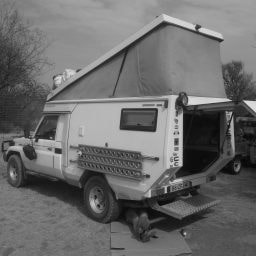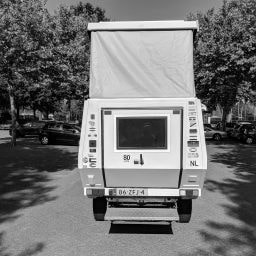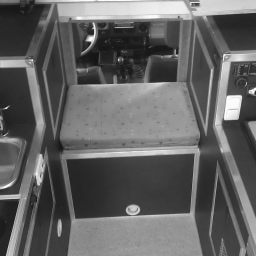Choice of Vehicle
|
Choice of vehicle - Toyota Landcruiser HZJ79 Camper
We have, after extensive research finally chosen a Toyota LandCruiser HZJ79 2000 with motorhome construction. The HZJ79 is a four-wheel drive pickup truck. We bought it at Innovation Campers, in Lienen near Osnabruck in Germany. The vehicle was delivered in 2000 by the same company, has been used in Europe and Southern Africa and finally came back to Germany. At the moment of purchasing it had 127,000 km on the clock. The camper construction was renovated by Innovation Campers, the vehicle itself by Toyota. Below is a summary of the main alternatives that we looked at and the reasons why we didn't choose them. Our Requirements We had a number of conditions that the vehicle had to meet:
Brands other than Toyota The most common four-wheel drive makes for African conditions are Landrover and Toyota. Mercedes and Nissan are also alternatives, but are little used locally. Unimog etc. are too heavy for our needs. We read everywhere that Land Rover is nice if like some repairing every day; we are not! Landrover never dies, but is often sick. It therefore became a Toyota. Other models than the LandCruiser We looked at two Toyota models: the LandCruiser and Hilux. The Hilux is more modern (turbo, more electronics than the Land Cruisers we look at - see below). They are therefore more efficient and have lower CO2 emissions, but if you one get poor quality diesel (not imaginary in Africa) you can damage your engine beyond repair, so it was no option. Moreover, for me (2.05 m tall) the driver's space was too cramped. Other models than the HZJ7X From the models that are no oldtimer yet the 70 series, 80 series and 100 series come into account. The 100-series is much more luxurious (and therefore more expensive), the 80-series (and 105) are similar to the 70 series motor, but have a newer body design. Few are in circulation and there are even fewer in the Netherlands. HZJ79 After the elimination of many vehicles there were two alternatives left: the HZJ78 with swinging roof and HZJ79 camper structure. The HZJ75 was another option, but is old. In itself, the 78 and 79 were both acceptable, but we had a preference for the 79 because the camper structure offers more space. Too New Model The problem of too recent a vehicle is the amount of tax (BPM) that you have to pay in the Netherlands: for a new vehicle like the HZJ79 tax would be more than the base price of the vehicle . The HZJ79 was never introduced in the Netherlands, the HZJ78 not anymore since ten years. In the balance between age and costs we decided that it had to be built between 2000 and 2006. Standard HZJ79 with second hand camper construction Now we had two options: a standard HZJ79 with a camper built to specification or a used, ready made one. This was mainly determined by what was found. The advantages and disadvantages are obvious: in a new one everything is new (eh eh) and you can make all decisions about the interior yourself. However, delivery times of reputable builders were more than a year and the total cost was much higher. Therefore, when we were offered a HZJ79 2000 with a reasonable number of km on the clock and a camper interior that met our requirements, we chose for it. After all, only after you have traveled in the vehicle for an extended period of time you really know what you want. After nearly three years of traveling we completely refurbished the interior. We definitely wouldn't have ordered it initially in the way we did the refurbishment. Innovation Campers Buying from a reputable supplier is vital. In addition to all usual opinions about used vehicles and their vendors the fact that these are vehicles that are very expensive for their age and that you will be dependent on them for long periods makes the vendor selection even more critical. We looked at several vendors, but eventually two alternatives were left: Innovation Campers in Lienen in Germany and AutoConnections in St. Oedenrode, Netherlands, which is around the corner for us. Lienen is about three hours away from our home, so that's reasonable; there are other good suppliers in Germany and Switzerland as well, but the distance becameimpractical. Innovation Campers has built in some 15 years about 150 campers. In spring 2012 we went to the "Fernreisetreffen 2012" which was attended by many customers of Innovation Campers. There we had ample opportunity to discuss their experiences. The feedback was very good. Moreover, because a comparable offer from Innovation Campers was significantly cheaper than from AutoConnections we eventually chose for Innovation Campers. |
Vehicle Preparation
The following was done before we set off:
- New tires: the vehicle had Mud / Terrain tires which were already very worn. We replaced them with All Terrain tires because we expected to drive mostly paved roads and dirt roads. The new tires made a lot less noise and were expected to last longer. We chose BF Goodrich again, the brand that most overlanders select;
- New rims: the vehicle had spacers. Mechanically inferior and more difficult to repair. We now have rims with tires further standing out, so that the spacers are no longer needed;
- New starter;
- New alternator with increased capacity: 120 A instead of 70 A. This appeared to be in retrospect not to be so wise: we had a separation unit that connects the household batteries with the starter batteries when the engine is running . However its protection circuitry switches the connection off if the supply current to the household batteries exceeds 70 A. If the voltage of household batteries was too low the household batteries were drawing too much current, causing the protection circuitry to trigger. The consequence is that charging of the household batteries using the alternator began only if they were already partially charged by he solar panel (i.e., if it is not so much needed anymore). With the aging of the household batteries this phenomenon got worse;
- Replacing brake discs and shoes;
- Addition of an extra fuel filter;
- Adjusted of bearings;
- Replacing V-belts;
- Replacement of rubbers and buses of springs and stabilizers;
- Extension of axes vent hoses, so that they do not come under water as you go through deep water;
- The timing belt was replaced just before we bought the vehicle, so that was not necessary;
- In the original delivery, the connecting shaft between the gearbox and the transfer box was strengthened. This is a weakness of the original Toyota (improved later) and therefore was not required during this preparation;
- All routine maintenance activities (oil change, replacing brake fluid, ...).
Inventory for the Vehicle
Spare parts, maintenance equipment, books and tools that we carry:
|
Vehicle
Books
|
Tools
|





